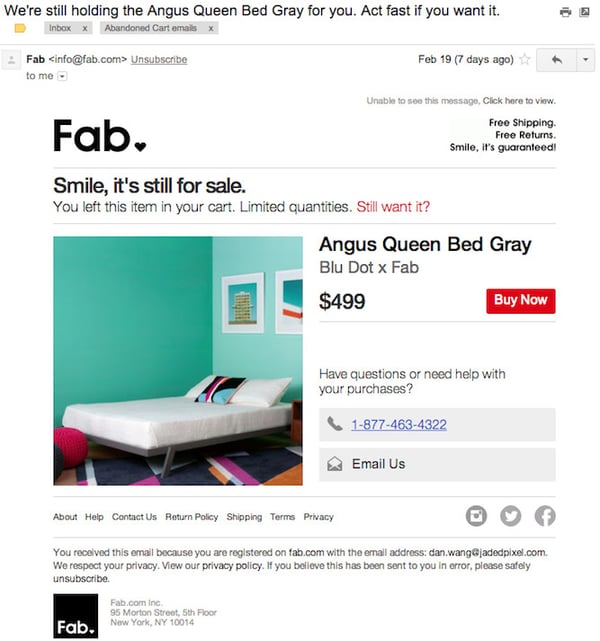Ecommerce personalization is about creating individualized interactions and experiences for users.
Ecommerce giants like Amazon have set the standard in personalized strategies, but no matter the scale of the business, brands that develop experiences for their users that focus squarely on their needs will see the results.
This comes from really knowing who your audience is, which means gathering insights from more than just demographic data – but behavioral, attitudinal and psychographic.
Deep consumer data helps brands build up a picture of their audiences, enabling them to offer tailored content that meets the differing needs and expectations of their customers.
Why ecommerce personalization is worth the effort
Personalized marketing delivers results.
We’ve seen this from the likes of Amazon and Netflix to smaller retailers like Fab and Campus Protein. Why? Research suggests users respond best to content that speaks directly to them.
According to Marketingprofs:
Businesses that adopt personalized marketing see an average 19% increase in sales.
What’s more, users increasingly expect content they’re exposed to (branded or otherwise) to relate to their interests and life stages across multiple channels.
Our latest data shows 34% of internet users are most motivated to recommend a brand that provides them with things that are relevant to their own interests.
This is why personalization is becoming the norm across all digital marketing mediums – most notably email marketing, onsite promotion and user experience.
Here are 10 examples of brands that have mastered the art of ecommerce personalization.
Ecommerce personalization examples
Depending on the nature of the business and its model, certain personalization processes may be more effective than others.
Therefore, it’s important to keep track of what your competitors are doing, and monitor what’s working for you.
We’ve separated the personalization processes into two categories, ‘onsite’ and ‘offsite’.
This makes it easier to see how brands are incorporating personalization in both inbound and outbound strategies.
Onsite personalization
Personalization is key to any inbound marketing strategy.
With agile websites able to provide content tailored to consumers, retail brands can provide a more one-to-one onsite shopping experience in real time.
1. Campus Protein: Segmented best-sellers.
Consumers are drawn to products they know have sold well.
‘Most popular’ ranges receive a strong click-through rate. For this reason, ecommerce sites place this content in a dominant position on the page, either in the ‘basket’ section, or alongside the product descriptions.
Campus Protein, with the support of Shopify, have used this technique to great effect.
Their curated list of ‘top 25’ best-selling products can be segmented by date range, enabling users to check which products are trending, and which have sold well over the long-term.
This increased Campus Protein’s click-through rate by 50% from the best-seller to the product pages.
2. Alloy Apparel: Personalized best-sellers.
Alloy Apparel took this approach to a new level.
The retailers present the ‘most popular’ items based on the shopper’s demographic and behavioral data.
By pooling both demographic data gathered from their accounts and behavioral data gathered from website interactions, Alloy Apparel can create highly personalized recommendations.
Combining this with the added attraction of the items being ‘most popular’, adds to their purchase appeal.
3. Levi’s: Chatbot assistance.
Our research shows 20% of internet users would be motivated to recommend a brand that offers a one-to-one relationship with them.
One of the drawbacks of online shopping, especially when it comes to clothing, is being unable to speak directly to an assistant for advice.
Denim experts, Levi’s, navigate this problem with its chatbot, Ask Indigo.
Perhaps one of the more futuristic personalization techniques, Ask Indigo suggest clothing items based on the user’s preferences.
Here’s how it works:
By offering users a service that speaks to them directly, albeit through a voice programmed by an algorithm, Levi’s leverage personalization to enhance brand interaction, positioning highly relevant products in front of the customer.
4. ASOS: Smart navigation.
ASOS takes agile website personalization to the extreme, changing the whole navigation based on past user engagement.
The brand’s most notable personalization feature is created via dynamic interfaces, which change depending on what pages of the site users have visited before.
For example, if a user viewed items in the women’s clothing part of the site, then the next time the user visited ASOS, they would automatically be presented with the women’s section, without having to click through.
This helps with the overall customer experience.
By skipping a step in the user journey, ASOS can position gender-specific content in front of the user straight after they click through from search engines.
5. Tesco: Recently purchased items.
Personalization is often associated with sales of one-offs and desirable items. It’s also been effective for upselling products purchased on a regular basis – in this case food and household items.
Tesco offers a speedier shopping experience through their ‘recently purchased’ section once a user logs into their account.
The user is presented with a graphic chart of items they have regularly purchased, meaning they can save time searching for items and instead add them directly to their cart.
Not only does this provide a helpful service to users, meaning they avoid forgetting to purchase items they may need, it also enables the retailer to cross-sell suggested items the user might also be interested in purchasing, helping to increase conversions overall and improve the average order value.
6. Nespresso: Membership clubs.
Coffee experts, Nespresso, offer a membership to its users designed to make them feel part of a private club.
Despite being open to all visitors, Nespresso and You offers a range of seemingly exclusive deals tailored to individual preference, based on questions asked during sign-up and purchase history.
The perks include discounts, classes, freebees, coffee machine warranty and free delivery.
The most effective loyalty programs are the ones that evoke feelings of exclusivity and make the customer feel valued.
Offsite personalization
Outbound marketing channels, such as paid advertising and email marketing are often personalized to individual users.
The type of personalization utilized depends on the types of consumer data valued by the company, but, the vast majority of outbound marketing is based on onsite behavior and account information.
Here are the brands that do it well:
1. Uber Eats: Directly addressing the customer.
Many brands with a progressive email campaign strategy will already be doing this. But some do it better than others.
Uber Eats’ latest promotional deal was sent to its account holders, with the subject line, “[first name] Doesn’t Share Food”.
Placing the user’s first name in the subject line makes the email stand out in the inbox and combined with the familiar catchphrase from a popular sitcom, Friends, this email is both personal and familiar before you’ve even opened it.
2. Fab: Abandoned cart emails.
The aim of the abandoned cart email is to re-engage users who’ve added an item to their cart, but never carried out the purchase.
Ecommerce retailer, Fab, effectively adds an extra dimension to this personalized marketing technique, by notifying users when stocks are low in the items they’ve added to their cart.

Source: Fab.com
Fab’s email is effective in its messaging, acting as a helpful and friendly reminder. Explaining to the customer that stocks are limited is an honest reason to contact them directly.
Setting up these emails is very simple. Once designed and written, abandoned cart emails can be automated, so they only really need updating occasionally.
Although an effective way to boost revenue, many major retailers in the U.S. are failing to capitalize on this.
3. Adidas: Tailored promotional offers.
Discounts, free gifts are excellent ways to hook users in.
Often, blanket offers are provided over certain product ranges throughout the year. But when these are personalized, it adds fluidity to the customer journey.
Adidas segments their promotional offers by gender to avoid miss-targeted deals.
Here’s how they look:
Source: Campaign Monitor
Promotional offers can also be segmented based on consumer behavior, for example, new, loyal, or dormant customers to help incentivize or remind them to re-engage with your brand at various touch points.
4. Point Defiance Zoo & Aquarium: Personalized discounts.
43% of internet users would be motivated to recommend a brand that provided them with discounts and free gifts.
With the aim of increasing membership numbers, the Washington team at Point Defiance Zoo and Aquarium analyzed their data to identify which areas were home to the zoo’s most frequent guests.
They used this data to target hotspot postcodes with discounts.
The result was a 13% increase in membership in the first 3 months.
Consumer profiling by geo-location enables brands to target lookalike consumers to expand their reach in a more targeted way.
Taking ecommerce personalization to the next level
Many ecommerce businesses rely solely on demographic and behavioral data to shape their personalized marketing strategies. Taking it to the next level means going deeper with your research.
Let’s take a hypothetical example.
You’re a marketing planner working in the beauty industry, aiming to raise awareness of your brand amongst Gen Z females.
From your behavioral research and previous campaign results, you’ve deciphered that they’re very active on social media, and consider this a primary channel to promote your ads.
You know where these consumers are spending their time, but relying on this alone would likely lead to miss-messaging and wasted resource.
To deliver an experience that’s truly personal and relevant to their interests you need to uncover why they’re active here, and the types of content they’re consuming.
Here’s what our latest data reveals:

Gen Zers are most likely to discover brands via online ads, and they research them via social media. This confirms a paid social media campaign would be effective for raising awareness.
Combining the what with the why in this way helps shape a personalized ecommerce marketing campaign that not only targets customers where they’re active, but ensures your messaging doesn’t fall on deaf ears.
Making it work
There are numerous ways to integrate personalization into an ecommerce model.
But while many brands will focus solely on behavioral data to drive their strategy, in today’s complex landscape, it takes far more to capture consumer attention.
This is where deeper consumer insight comes into play – the kind that complements data around actions to give your approach legs.
Being empathetic towards the unique requirements of your customers will allow your business to make intelligent decisions, and create a personalized shopping experience that offers solutions tailored to their needs as consumers, but which simultaneously speaks directly to them, on a human level.
Most importantly, personalization is one area in which ecommerce brands can compete with the most dominant players in the space, like Amazon and ASOS.
It doesn’t come down to budget or awareness, it’s about one key principle: creating the most tailored experience for your user.





.webp?width=495&height=317&name=pink_thumb_graphs%20(1).webp)
.webp?width=495&height=317&name=pink_thumb_letter%20(2).webp)
